|
History of steel drums (steel pans)-An Inspiring Story!!Although steel drums (steel pans) were invented in the Caribbean island of Trinidad and Tobago sometime around the Second World War, they had been evolving since the 1800's when the inhabitants were celebrating Carnival (a street parade). This festivity was brought to the island by the French. After the slaves were freed in 1834, they joined in the festivities using their drums. However,the colonialists were nervous about the drumming which they thought could be used to pass secret messages that may have led to social unity and a possible revolution among the Blacks. The drumming activities were therefore banned.This did not stop the natives however! They replaced their drums with tuned bamboo sticks called Tamboo Bamboo. ("Tamboo" is derived from the French name for drums-Tambour). The larger sticks were stomped on the ground,and the smaller ones were struck together. This is what these instruments look like:
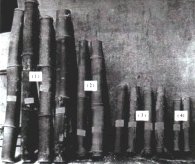
During the 1930's biscuit tins ( beaten with bare sticks) were included as rhythm instruments in the Tamboo Bamboo bands. However, because of fights between rival gangs, the Tamboo Bamboo bands were forbidden.This led to street bands being comprised exclusively of steel instruments such as tin pans, biscuit drums, dustbins and other items such as brake drums and spoons(!). These bands were often referred to as "Iron Bands" or " Pan Bands". It was not long before The players noticed that their steel instruments changed pitch after being beaten for a while. With Carnival being forbidden during World War II for security reasons,the earliest steel pan pioneers had more time to experiment with and improve on the quality of sound from their steel instruments.The very first steel drums with pitches(notes)were made from smaller metal containers and were convex in shape. 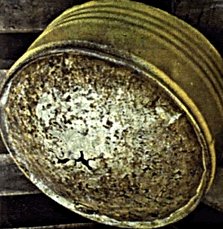
From around 1948 the small pans were replaced with the bigger ones made from the readily available 55 gallon oil drums that were discarded by the oil refineries on the island.The first steel drum with the 12 notes of the Chromatic Scale was developed. The former convex shape of the steel drums had also been changed to a concave shape to accommodate more notes.The notes were formed with convex shaped dents. Rubber was also wrapped around the pan sticks (mallets) to make its sound more mellow. Ellie Mannette has been credited with these specific improvements and he is thus widely regarded as the father of the modern steel drum (steel pan). Other notable contributors to the development of this instrument are Bertie Marshall and Anthony Williams, but there were many more. Fifty years after the Second World War, pan makers have developed the steel drum into the marvelous instrument that it is today through sophisticated experimentation with the metal parameters, intuition and a good musical ear. This is what the modern steel drum (steel pan) looks like. The name of this particular one is called a Tenor Pan. 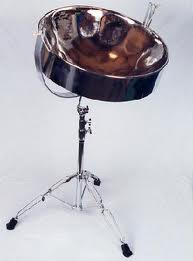
There are several types of steel pans that have been developed to match the functions of the various conventional instruments in terms of pitch range. The development of different steel pans with their own unique tone was rapid. Ellie Mannette and Neville Jules emerged as top class steel drum tuners. At the same time, bands were being formed across the island with some of them adopting names from American movies such as Destination Tokyo, Casablanca, Rising Sun, Invaders, Tripoli, Bar 20, Red Army, Desperadoes. Here is a photo of Ellie Mannette tuning with a stroboscope. He is a real innovator! 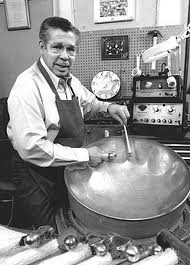
In the last 40 years, the bands have come quite a long way, moving from the pan yards(where they are kept) in the most depressed areas of society to some of the world's most prestigious concert halls. The Desperadoes, for instance, have performed at the Royal Albert Hall in London, Carnegie Hall, the Apollo and Lincoln Theaters in New York, the United Nations building, and the Kennedy Center in Washington, D.C. Other bands like Renegades, All Stars, Phase Two and Exodus have thrilled audiences from London to Paris to Japan,with renditions of some of the most complex works of composers such as Bach, Beethoven, Mozart, Sibelius,Rossini and Borodin, to name a few. The band shown here is Exodus, which is performing at the Annual World Music Festival in Trinidad and Tobago. 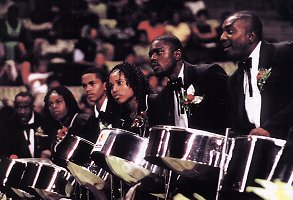
The steel pan is now the National Instrument of Trinidad and Tobago, which is quite fitting for an instrument that was forged from the resilience of a people that were subjected to suppression and hardship! |